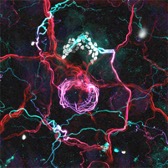Ellen Lumpkin

Professor of Cell Biology, Development and Physiology*
**And Affiliate, Division of Neurobiology
Research Interests
The somatosensory system continuously updates our brains about the forces, temperatures and chemicals that incessantly bombard our bodies. The goal of our research is to discover molecular mechanisms that encode these diverse environmental stimuli into neural signals. Our primary focus is to elucidate force transduction mechanisms that initiate the senses of touch and pain. Although Aristotle designated it as one of five basic senses, touch is a complex sense that encompasses numerous modalities (e.g., stretch, pressure, hair movements, vibration). Correspondingly, the touch-sensitive neurons that tile the body's surface display a remarkable array of force sensitivities, neural outputs and cellular morphologies. Although forward genetic screens have identified dozens of essential molecules in invertebrate mechanosensory neurons, we are only now beginning to uncover molecular players that govern the unique functions of touch receptors in mammals. We have developed in vitro and in vivo tools to discover the basis of sensory transduction in a light touch receptor, the Merkel cell-neurite complex. These touch receptors innervate highly sensitive (high-acuity) areas such as fingertips, where they encode spatial features of objects. We use neurophysiological techniques to directly observe how individual, living touch receptors respond to force. We also use molecular approaches and mouse genetics to identify molecules that allow mechanoreceptor cells to sense force. Neural circuits that process tactile information are another area of interest.
Current Projects

Image courtesy of Blair Jenkins.
In much of our research, we work closely with the research team of my colleague and friend Professor Diana M. Bautista. Our main projects involve: (a) identifying and understanding the molecular basis of the specification and differentiation of cells of the mammalian somatosensory system; (b) identifying and analyzing the biophysical characteristics of mammalian touch receptors and ion channels, and the mechanisms of their mechanosensory transduction; and, (c) characterizing the synapses and neuronal circuitry involved in sensory physiology.
Selected Publications
Focused ultrasound excites action potentials in mammalian peripheral neurons in part through the mechanically gated ion channel PIEZO2. Hoffman BU, Baba Y, Lee SA, Tong CK, Konofagou EE, Lumpkin EA. Proc Natl Acad Sci U S A. 2022 May 24;119(21):e2115821119. doi: 10.1073/pnas.2115821119
Somatosensory innervation of healthy human oral tissues. Moayedi Y, Michlig S, Park M, Koch A, Lumpkin EA. J Comp Neurol. 2021 Aug 1;529(11):3046-3061. doi: 10.1002/cne.25148
Touching Base with Mechanical Pain. Arenas OM, Lumpkin EA. Cell. 2020 Mar 5;180(5):824-826. doi: 10.1016/j.cell.2020.02.022
The signaling lipid sphingosine 1-phosphate regulates mechanical pain. Hill RZ, Hoffman BU, Morita T, Campos SM, Lumpkin EA, Brem RB, Bautista DM. Elife. 2018 Mar 21;7:e33285. doi: 10.7554/eLife.33285
Mammalian touch catches up. Walsh CM, Bautista DM, Lumpkin EA. Curr Opin Neurobiol. 2015 Oct;34:133-9. doi: 10.1016/j.conb.2015.05.003
The ion channel TRPA1 is required for chronic itch. Wilson SR, Nelson AM, Batia L, Morita T, Estandian D, Owens DM, Lumpkin EA, Bautista DM. J Neurosci. 2013 May 29;33(22):9283-94. doi: 10.1523/JNEUROSCI.5318-12.2013
Perspectives on: information and coding in mammalian sensory physiology: probing mammalian touch transduction. Bautista DM, Lumpkin EA. J Gen Physiol. 2011 Sep;138(3):291-301. doi: 10.1085/jgp.201110637
Photo Credit: John Pinderhughes
Last Updated 2022-09-23